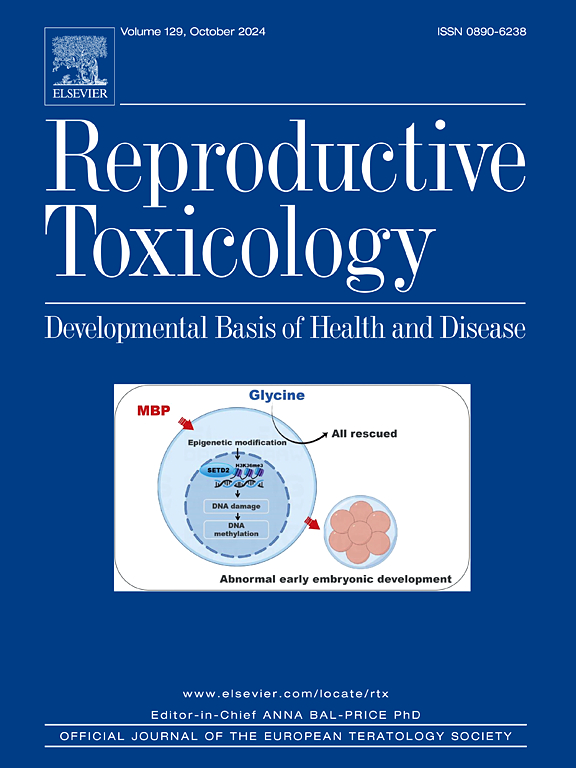Repair effect of adipose-derived mesenchymal stem cell-conditioned medium on cyclophosphamide-induced ovarian injury in mice
IF 2.8
4区 医学
Q2 REPRODUCTIVE BIOLOGY
引用次数: 0
Abstract
The chemotherapeutic drug cyclophosphamide (CTX) may damage the ovarian tissue of females and induce premature ovarian insufficiency (POI). This study aimed to investigate the therapeutic effect of adipose-derived mesenchymal stem cell-conditioned medium (ADSC-CM) on CTX-induced POI mice, and to provide new support for the clinical use of cell-free therapy for POI. Female mice were treated with CTX intraperitoneal injection for 2 weeks, followed by ADSCs or ADSC-CM by intravenous injection for 2 weeks. At the end of the experiment, various parameters were assessed, including ovarian interstitial fibrosis, cell proliferation, follicular count, the levels of follicle-stimulating hormone (FSH) and estradiol (E2), and the expression of gonadal hormone receptor. Additionally, we assessed the levels of oxidative stress, apoptosis, and apoptosis signal-regulating kinase 1 (ASK1)/c-Jun N-terminal kinase (JNK) signaling pathway-related proteins and genes in ovarian tissue. The results showed that ADSCs or ADSC-CM treatment reduced ovarian interstitial fibrosis, promoted the proliferation of cells in the follicles, and increased the number of follicles and ovarian function. In addition, ADSCs and ADSC-CM also reduced the levels of ovarian oxidative stress, decreased the apoptosis of granulosa cells (GCs), and inhibited the activation of ASK1/JNK signaling pathway. In conclusion, our study confirmed that ADSC-CM, like ADSCs, could exert therapeutic effects in POI diseases, and the underlying mechanism may be related to the inhibition of oxidative stress-mediated activation of ASK1/JNK signaling pathway. This study has important implications for the development of cell-free therapies for the clinical treatment of POI diseases.
脂肪源性间充质干细胞条件培养基对环磷酰胺诱导的小鼠卵巢损伤的修复作用
化疗药物环磷酰胺(CTX)可能损害女性卵巢组织,诱发卵巢早衰(POI)。本研究旨在探讨脂肪源性间充质干细胞条件培养基(ADSC-CM)对ctx诱导的POI小鼠的治疗作用,为无细胞治疗POI的临床应用提供新的支持。雌性小鼠腹腔注射CTX 2周,然后静脉注射ADSCs或ADSC-CM 2周。实验结束时,测定各组卵巢间质纤维化、细胞增殖、卵泡计数、促卵泡激素(FSH)、雌二醇(E2)水平、性激素受体表达等指标。此外,我们评估了卵巢组织中氧化应激、凋亡和凋亡信号调节激酶1 (ASK1)/c-Jun n末端激酶(JNK)信号通路相关蛋白和基因的水平。结果显示,ADSCs或ADSC-CM处理可减少卵巢间质纤维化,促进卵泡细胞增殖,增加卵泡数量,提高卵巢功能。此外,ADSCs和ADSC-CM还能降低卵巢氧化应激水平,减少颗粒细胞(GCs)的凋亡,抑制ASK1/JNK信号通路的激活。综上所述,我们的研究证实,ADSC-CM与ADSCs一样,可以在POI疾病中发挥治疗作用,其潜在机制可能与抑制氧化应激介导的ASK1/JNK信号通路激活有关。本研究对临床治疗POI疾病的无细胞疗法的发展具有重要意义。
本文章由计算机程序翻译,如有差异,请以英文原文为准。
求助全文
约1分钟内获得全文
求助全文
来源期刊

Reproductive toxicology
生物-毒理学
CiteScore
6.50
自引率
3.00%
发文量
131
审稿时长
45 days
期刊介绍:
Drawing from a large number of disciplines, Reproductive Toxicology publishes timely, original research on the influence of chemical and physical agents on reproduction. Written by and for obstetricians, pediatricians, embryologists, teratologists, geneticists, toxicologists, andrologists, and others interested in detecting potential reproductive hazards, the journal is a forum for communication among researchers and practitioners. Articles focus on the application of in vitro, animal and clinical research to the practice of clinical medicine.
All aspects of reproduction are within the scope of Reproductive Toxicology, including the formation and maturation of male and female gametes, sexual function, the events surrounding the fusion of gametes and the development of the fertilized ovum, nourishment and transport of the conceptus within the genital tract, implantation, embryogenesis, intrauterine growth, placentation and placental function, parturition, lactation and neonatal survival. Adverse reproductive effects in males will be considered as significant as adverse effects occurring in females. To provide a balanced presentation of approaches, equal emphasis will be given to clinical and animal or in vitro work. Typical end points that will be studied by contributors include infertility, sexual dysfunction, spontaneous abortion, malformations, abnormal histogenesis, stillbirth, intrauterine growth retardation, prematurity, behavioral abnormalities, and perinatal mortality.
 求助内容:
求助内容: 应助结果提醒方式:
应助结果提醒方式:


